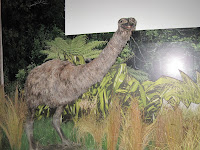 First a walk past seat of government today- the ugly modern Beehive, incongrous next to the classic Parliament House and neogothic Parliament library. Then I take the 2minute cable car up the hill. At the top is a cable car museum. I'm not so interested in how it all works but what did fascinate me was the short film about the 400+ small private and infinitely quirky cable cars that exist in Wellington to allow people living up the steep hillside to transport themselves as they get older, pets and groceries. I think "cable car" might have to onto the list of requirements for my future house (so far including turrets, secret passages and a double spiral staircase).
First a walk past seat of government today- the ugly modern Beehive, incongrous next to the classic Parliament House and neogothic Parliament library. Then I take the 2minute cable car up the hill. At the top is a cable car museum. I'm not so interested in how it all works but what did fascinate me was the short film about the 400+ small private and infinitely quirky cable cars that exist in Wellington to allow people living up the steep hillside to transport themselves as they get older, pets and groceries. I think "cable car" might have to onto the list of requirements for my future house (so far including turrets, secret passages and a double spiral staircase).
 |
| Moa Model |
It's the first time that this has been done on mainland New Zealand, many islands have already been turned into predator- free sanctuaries and endangered birds thrive there but constant monitoring and trapping of predators who swim to shore is needed.
Before Europeans reached New Zealand the Moa birds- some of them 3m high giants- were already extinct, probably largely due to hunting for food. With them went the giant eagle that used to eat them (or small children if it so desired). Europeans introduced the above species and also goats, deer, chamois and pigs. Actually I think I read somewhere that the stoats were to eat the rabbits- uh oh! Birds in New Zealand had evolved without mammalian predators ; and many with some unique quirky features, many lost the ability to fly and they would freeze in response to airborne predators who looked for movement. Additionally they took a long time to reproduce (unlike many other bird species where they can lay more eggs the same season if one clutch are lost). They were instantly vulnerable to predatory introduced- mammals and many of their fragile environments were damaged by deer, pigs and goats.
 |
| Takahe |
Among many, some I can't identify, I see the Kaka- a type of parrot and some Takahe- small turkey- sized birds with colourful feathers. There's certainly plenty of bird song as I wander along the paths. I return at night to spot the nocturnal Little Spotted Kiwi. We hear plenty of rustling about in the bush and hear the male's high pitched call before we finally see one. Terribly cute. The kiwi is another oddity- almost mammalian with fur-like feathers, nostrils at the end of its beak and barely any wings. There's also banks of glowworms, the Tuatara are out (a reptile in a class of it's own, that likely roamed the earth at the same time as the dinosaurs and may have had 3 eyes originally!) Maud island frogs, wetas (a giant grass-hopper sort of creature) and a native duck.

No comments:
Post a Comment